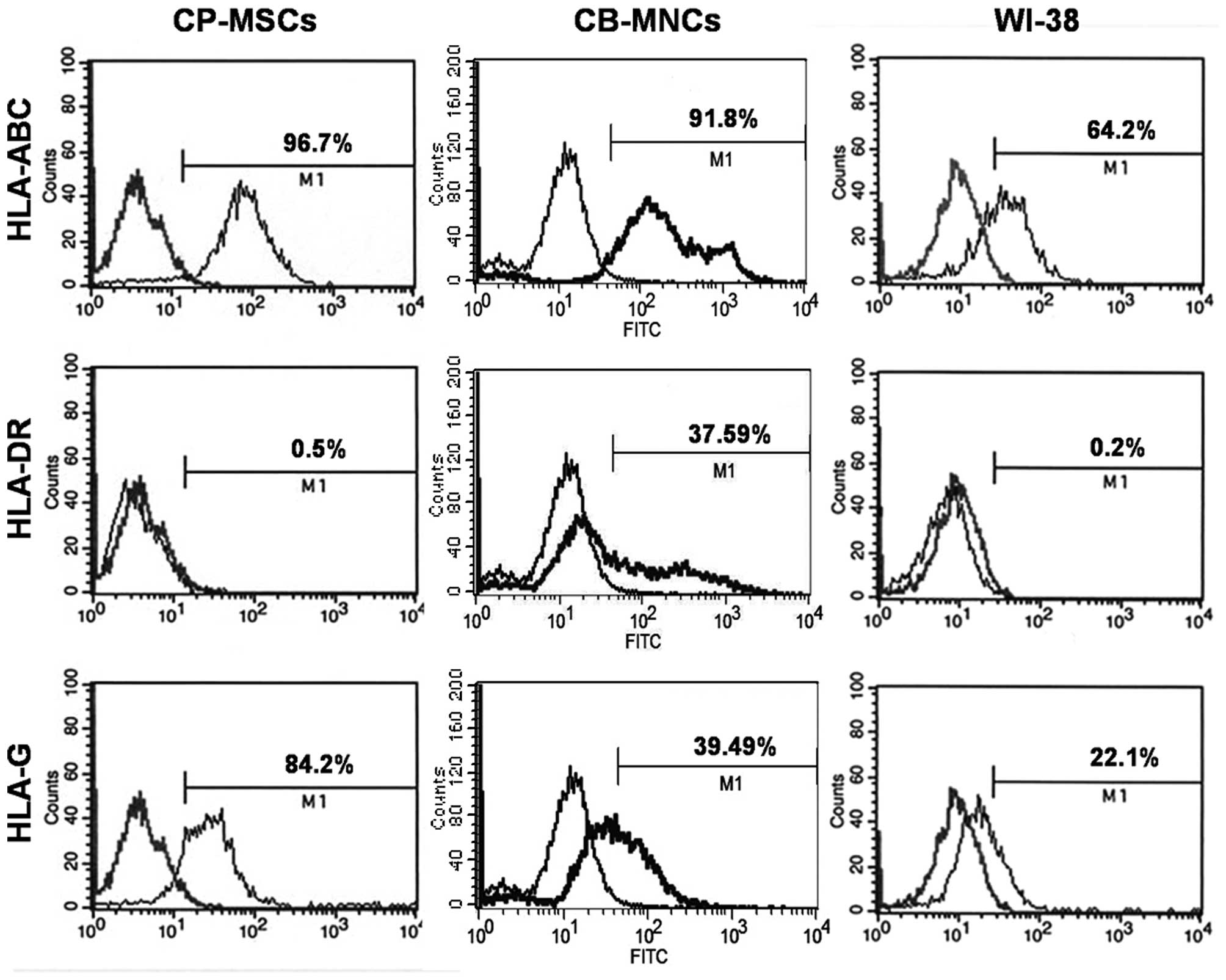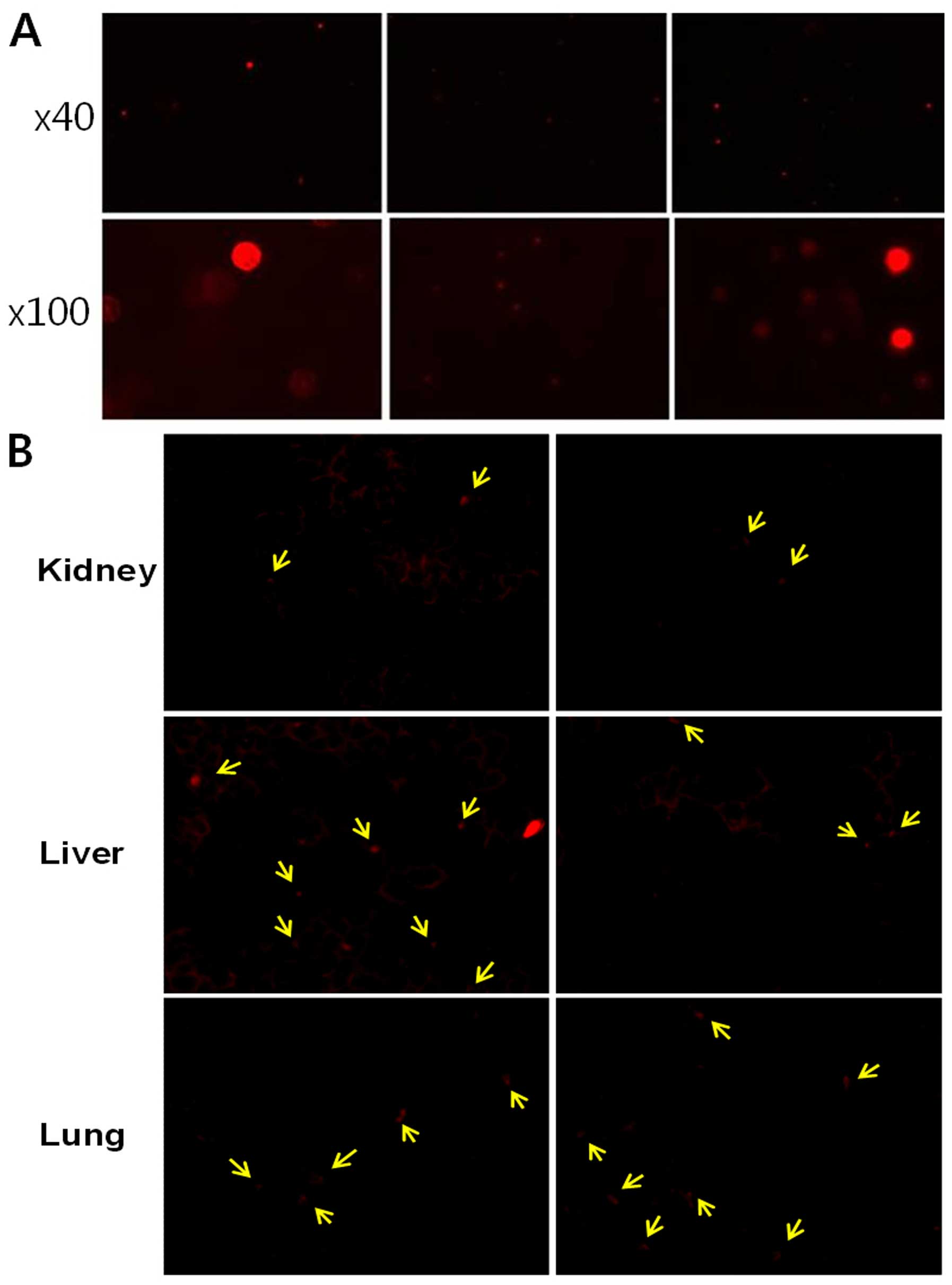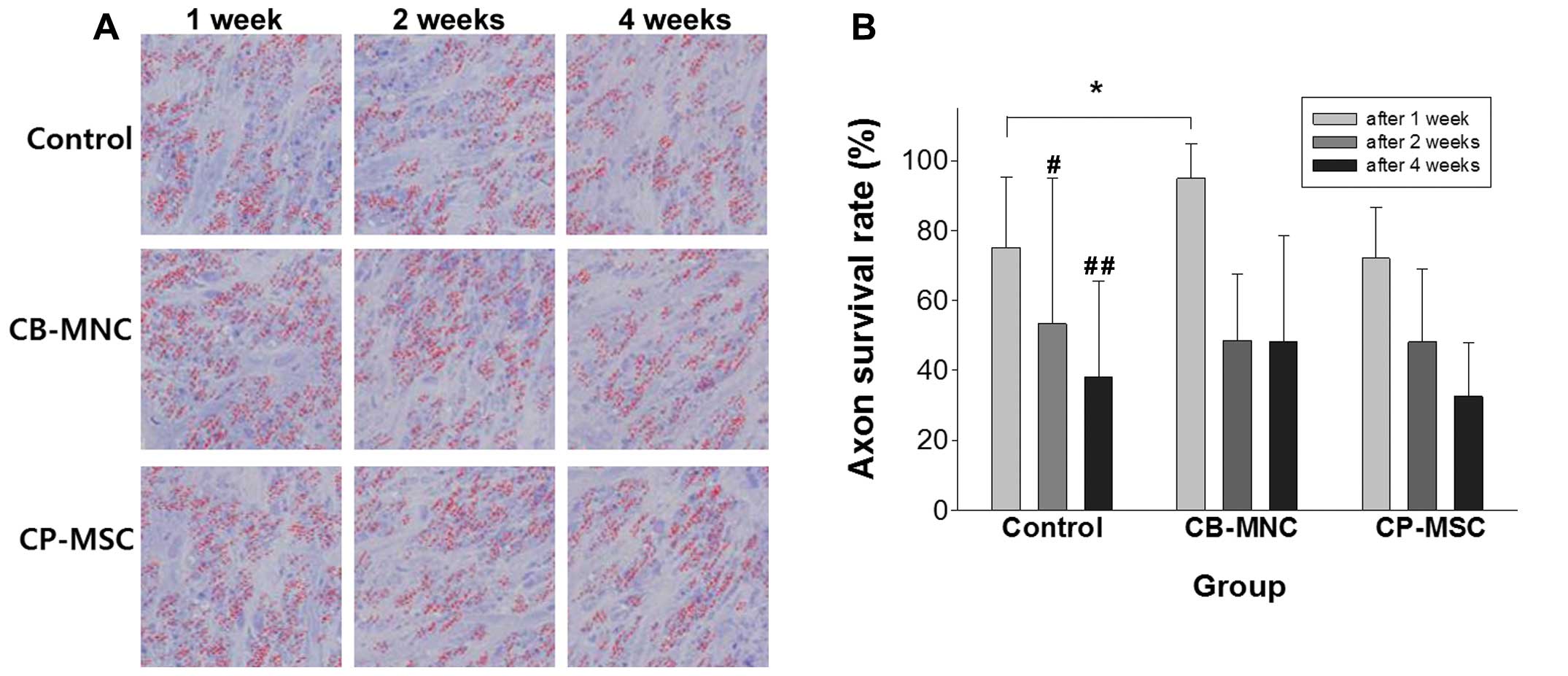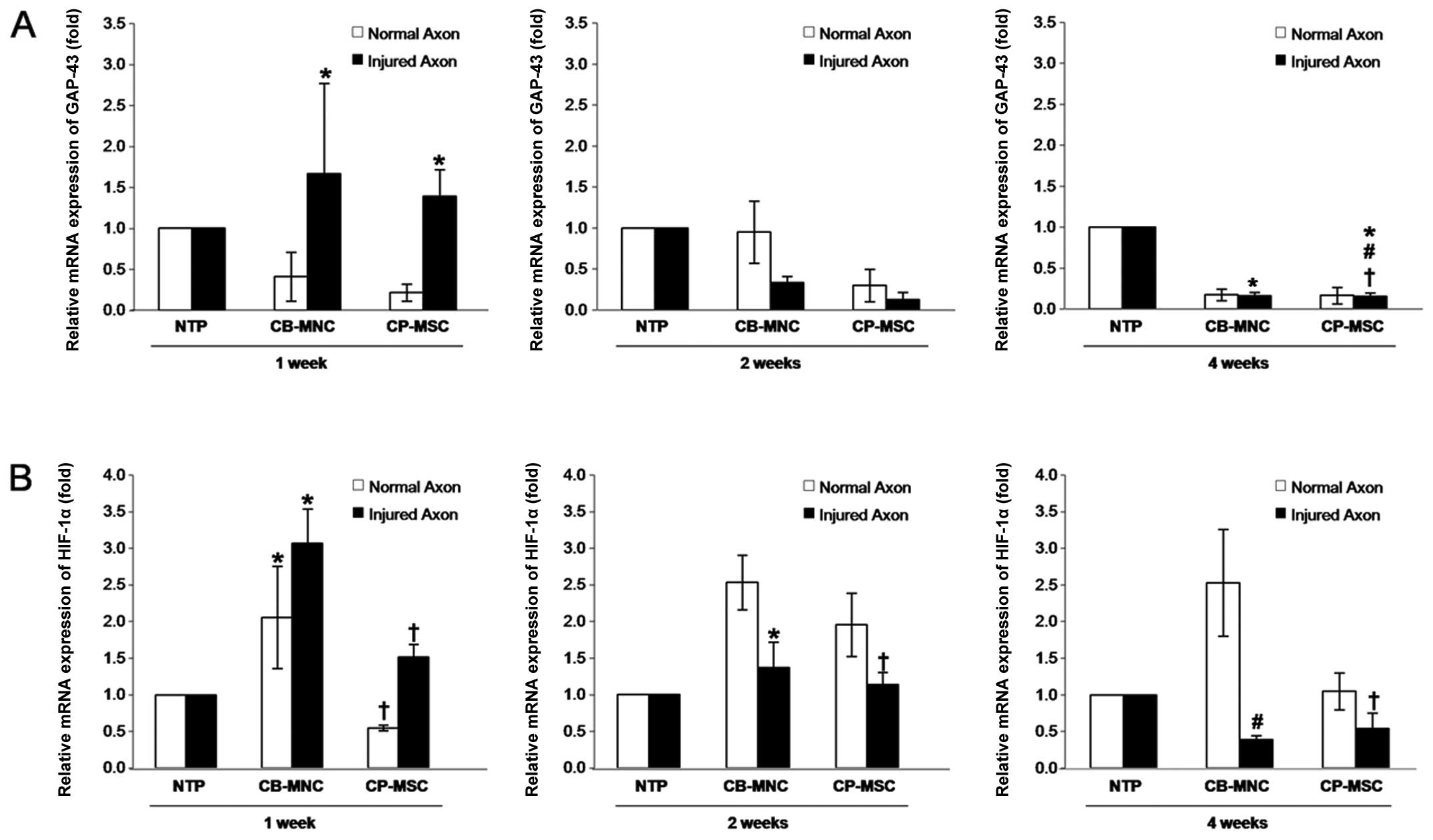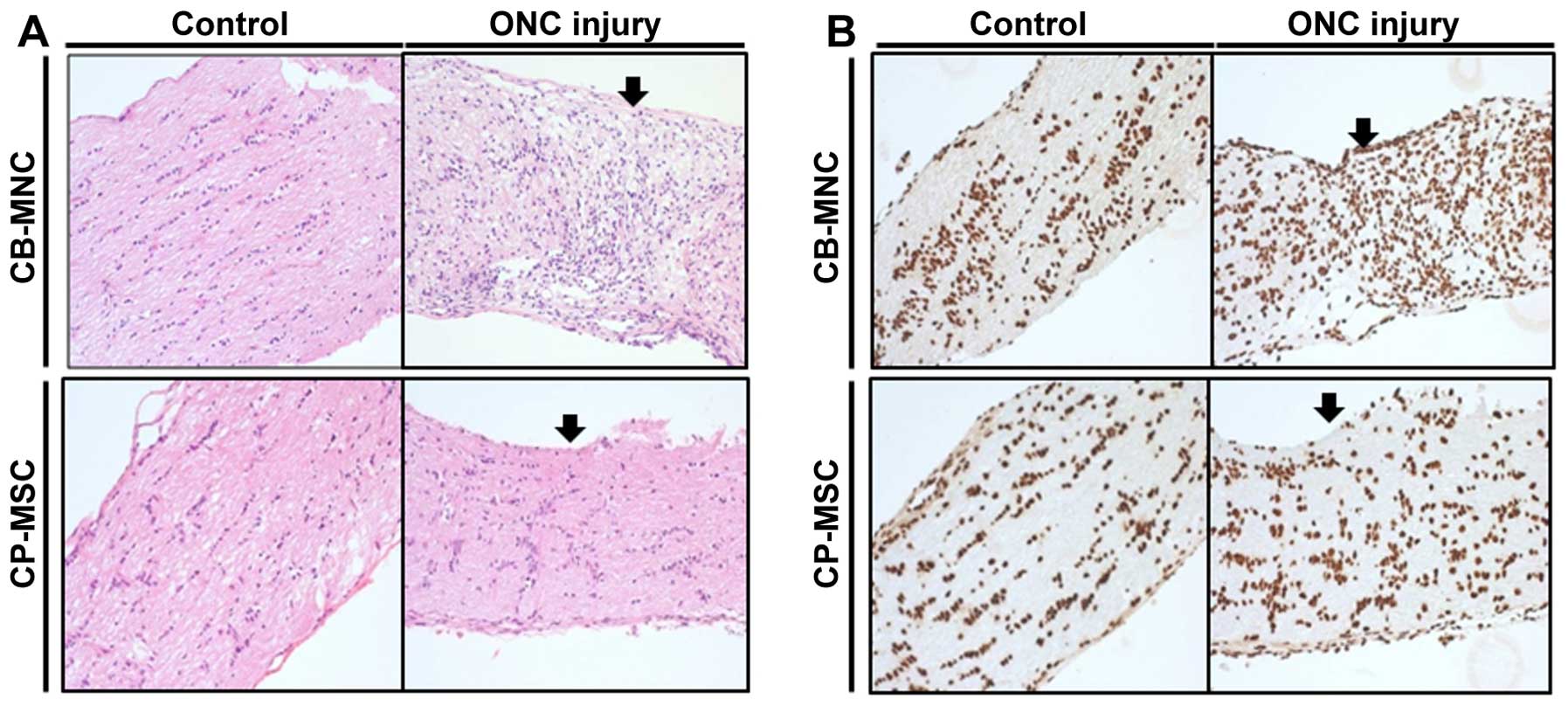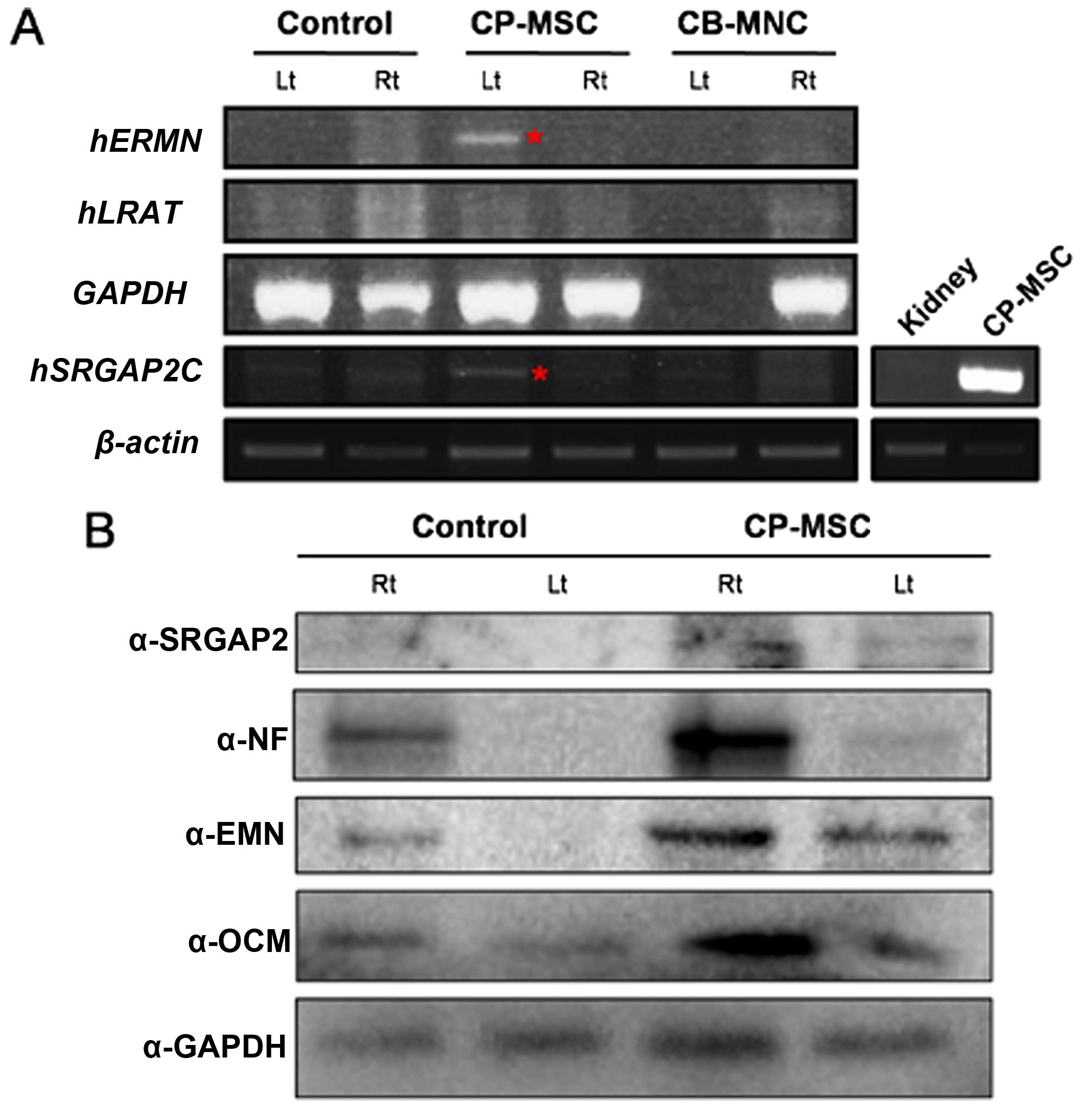|
1
|
Zhao T, Li Y, Tang L, Li Y, Fan F and
Jiang B: Protective effects of human umbilical cord blood stem cell
intravitreal transplantation against optic nerve injury in rats.
Graefes Arch Clin Exp Ophthalmol. 249:1021–1028. 2011. View Article : Google Scholar : PubMed/NCBI
|
|
2
|
Junyi L, Na L and Yan J: Mesenchymal stem
cells secrete brain-derived neurotrophic factor and promote retinal
ganglion cell survival after traumatic optic neuropathy. J
Craniofac Surg. 26:548–552. 2015. View Article : Google Scholar : PubMed/NCBI
|
|
3
|
Bull ND, Irvine KA, Franklin RJ and Martin
KR: Transplanted oligodendrocyte precursor cells reduce
neurodegeneration in a model of glaucoma. Invest Ophthalmol Vis
Sci. 50:4244–4253. 2009. View Article : Google Scholar : PubMed/NCBI
|
|
4
|
Aoki H, Hara A, Niwa M, Motohashi T,
Suzuki T and Kunisada T: Transplantation of cells from eye-like
structures differentiated from embryonic stem cells in vitro and in
vivo regeneration of retinal ganglion-like cells. Graefes Arch Clin
Exp Ophthalmol. 246:255–265. 2008. View Article : Google Scholar
|
|
5
|
Bull ND, Limb GA and Martin KR: Human
Müller stem cell (MIO-M1) transplantation in a rat model of
glaucoma: survival, differentiation, and integration. Invest
Ophthalmol Vis Sci. 49:3449–3456. 2008. View Article : Google Scholar : PubMed/NCBI
|
|
6
|
Levkovitch-Verbin H, Sadan O, Vander S,
Rosner M, Barhum Y, Melamed E, Offen D and Melamed S: Intravitreal
injections of neurotrophic factors secreting mesenchymal stem cells
are neuroprotective in rat eyes following optic nerve transection.
Invest Ophthalmol Vis Sci. 51:6394–6400. 2010. View Article : Google Scholar : PubMed/NCBI
|
|
7
|
Charalambous P, Hurst LA and Thanos S:
Engrafted chicken neural tube-derived stem cells support the innate
propensity for axonal regeneration within the rat optic nerve.
Invest Ophthalmol Vis Sci. 49:3513–3524. 2008. View Article : Google Scholar : PubMed/NCBI
|
|
8
|
Canque B, Camus S, Dalloul A, Kahn E,
Yagello M, Dezutter-Dambuyant C, Schmitt D, Schmitt C and Gluckman
JC: Characterization of dendritic cell differentiation pathways
from cord blood CD34(+)CD7(+)CD45RA(+) hematopoietic progenitor
cells. Blood. 96:3748–3756. 2000.PubMed/NCBI
|
|
9
|
Kao CH, Chen SH, Chio CC and Lin MT: Human
umbilical cord blood-derived CD34+ cells may attenuate
spinal cord injury by stimulating vascular endothelial and
neurotrophic factors. Shock. 29:49–55. 2008.
|
|
10
|
Lee MW, Jang IK, Yoo KH, Sung KW and Koo
HH: Stem and progenitor cells in human umbilical cord blood. Int J
Hematol. 92:45–51. 2010. View Article : Google Scholar : PubMed/NCBI
|
|
11
|
Min K, Song J, Kang JY, Ko J, Ryu JS, Kang
MS, Jang SJ, Kim SH, Oh D, Kim MK, et al: Umbilical cord blood
therapy potentiated with erythropoietin for children with cerebral
palsy: a double-blind, randomized, placebo-controlled trial. Stem
Cells. 31:581–591. 2013. View Article : Google Scholar : PubMed/NCBI
|
|
12
|
Newcomb JD, Sanberg PR, Klasko SK and
Willing AE: Umbilical cord blood research: current and future
perspectives. Cell Transplant. 16:151–158. 2007.PubMed/NCBI
|
|
13
|
Lu D, Sanberg PR, Mahmood A, Li Y, Wang L,
Sanchez-Ramos J and Chopp M: Intravenous administration of human
umbilical cord blood reduces neurological deficit in the rat after
traumatic brain injury. Cell Transplant. 11:275–281.
2002.PubMed/NCBI
|
|
14
|
Meier C, Middelanis J, Wasielewski B,
Neuhoff S, Roth-Haerer A, Gantert M, Dinse HR, Dermietzel R and
Jensen A: Spastic paresis after perinatal brain damage in rats is
reduced by human cord blood mononuclear cells. Pediatr Res.
59:244–249. 2006. View Article : Google Scholar : PubMed/NCBI
|
|
15
|
Nan Z, Grande A, Sanberg CD, Sanberg PR
and Low WC: Infusion of human umbilical cord blood ameliorates
neurologic deficits in rats with hemorrhagic brain injury. Ann N Y
Acad Sci. 1049:84–96. 2005. View Article : Google Scholar : PubMed/NCBI
|
|
16
|
Nikolic WV, Hou H, Town T, Zhu Y, Giunta
B, Sanberg CD, Zeng J, Luo D, Ehrhart J, Mori T, et al:
Peripherally administered human umbilical cord blood cells reduce
parenchymal and vascular beta-amyloid deposits in Alzheimer mice.
Stem Cells Dev. 17:423–439. 2008. View Article : Google Scholar : PubMed/NCBI
|
|
17
|
Papadopoulos KI, Low SS, Aw TC and
Chantarojanasiri T: Safety and feasibility of autologous umbilical
cord blood transfusion in 2 toddlers with cerebral palsy and the
role of low dose granulocyte-colony stimulating factor injections.
Restor Neurol Neurosci. 29:17–22. 2011.PubMed/NCBI
|
|
18
|
Sun J, Allison J, McLaughlin C, Sledge L,
Waters-Pick B, Wease S and Kurtzberg J: Differences in quality
between privately and publicly banked umbilical cord blood units: a
pilot study of autologous cord blood infusion in children with
acquired neurologic disorders. Transfusion. 50:1980–1987. 2010.
View Article : Google Scholar : PubMed/NCBI
|
|
19
|
Vendrame M, Cassady J, Newcomb J, Butler
T, Pennypacker KR, Zigova T, Sanberg CD, Sanberg PR and Willing AE:
Infusion of human umbilical cord blood cells in a rat model of
stroke dose-dependently rescues behavioral deficits and reduces
infarct volume. Stroke. 35:2390–2395. 2004. View Article : Google Scholar : PubMed/NCBI
|
|
20
|
Kim MJ, Shin KS, Jeon JH, Lee DR, Shim SH,
Kim JK, Cha DH, Yoon TK and Kim GJ: Human chorionic-plate-derived
mesenchymal stem cells and Wharton's jelly-derived mesenchymal stem
cells: a comparative analysis of their potential as
placenta-derived stem cells. Cell Tissue Res. 346:53–64. 2011.
View Article : Google Scholar : PubMed/NCBI
|
|
21
|
Lee JM, Jung J, Lee HJ, Jeong SJ, Cho KJ,
Hwang SG and Kim GJ: Comparison of immunomodulatory effects of
placenta mesenchymal stem cells with bone marrow and adipose
mesenchymal stem cells. Int Immunopharmacol. 13:219–224. 2012.
View Article : Google Scholar : PubMed/NCBI
|
|
22
|
Parolini O, Alviano F, Bagnara GP, Bilic
G, Bühring HJ, Evangelista M, Hennerbichler S, Liu B, Magatti M,
Mao N, et al: Concise review: isolation and characterization of
cells from human term placenta: outcome of the first international
Workshop on Placenta Derived Stem Cells. Stem Cells. 26:300–311.
2008. View Article : Google Scholar
|
|
23
|
Jung J, Choi JH, Lee Y, Park JW, Oh IH,
Hwang SG, Kim KS and Kim GJ: Human placenta-derived mesenchymal
stem cells promote hepatic regeneration in CCl4-injured
rat liver model via increased autophagic mechanism. Stem Cells.
31:1584–1596. 2013. View Article : Google Scholar : PubMed/NCBI
|
|
24
|
Lee MJ, Jung J, Na KH, Moon JS, Lee HJ,
Kim JH, Kim GI, Kwon SW, Hwang SG and Kim GJ: Anti-fibrotic effect
of chorionic plate-derived mesenchymal stem cells isolated from
human placenta in a rat model of CCl4-injured liver:
potential application to the treatment of hepatic diseases. J Cell
Biochem. 111:1453–1463. 2010. View Article : Google Scholar : PubMed/NCBI
|
|
25
|
Koriyama Y, Homma K, Sugitani K, Higuchi
Y, Matsukawa T, Murayama D and Kato S: Upregulation of IGF-I in the
goldfish retinal ganglion cells during the early stage of optic
nerve regeneration. Neurochem Int. 50:749–756. 2007. View Article : Google Scholar : PubMed/NCBI
|
|
26
|
Benowitz LI and Yin Y: Optic nerve
regeneration. Arch Ophthalmol. 128:1059–1064. 2010. View Article : Google Scholar : PubMed/NCBI
|
|
27
|
Tajima T, Goda N, Fujiki N, Hishiki T,
Nishiyama Y, Senoo-Matsuda N, Shimazu M, Soga T, Yoshimura Y,
Johnson RS and Suematsu M: HIF-1alpha is necessary to support
gluconeogenesis during liver regeneration. Biochem Biophys Res
Commun. 387:789–794. 2009. View Article : Google Scholar : PubMed/NCBI
|
|
28
|
Booij JC, ten Brink JB, Swagemakers SM,
Verkerk AJ, Essing AH, van der Spek PJ and Bergen AA: A new
strategy to identify and annotate human RPE-specific gene
expression. PLoS One. 5:e93412010. View Article : Google Scholar : PubMed/NCBI
|
|
29
|
Guerrier S, Coutinho-Budd J, Sassa T,
Gresset A, Jordan NV, Chen K, Jin WL, Frost A and Polleux F: The
F-BAR domain of srGAP2 induces membrane protrusions required for
neuronal migration and morphogenesis. Cell. 138:990–1004. 2009.
View Article : Google Scholar : PubMed/NCBI
|
|
30
|
Dennis MY, Nuttle X, Sudmant PH, Antonacci
F, Graves TA, Nefedov M, Rosenfeld JA, Sajjadian S, Malig M,
Kotkiewicz H, et al: Evolution of human-specific neural SRGAP2
genes by incomplete segmental duplication. Cell. 149:912–922. 2012.
View Article : Google Scholar : PubMed/NCBI
|
|
31
|
Kato S, Devadas M, Okada K, Shimada Y,
Ohkawa M, Muramoto K, Takizawa N and Matsukawa T: Fast and slow
recovery phases of goldfish behavior after transection of the optic
nerve revealed by a computer image processing system. Neuroscience.
93:907–914. 1999. View Article : Google Scholar : PubMed/NCBI
|
|
32
|
Johnson TV, Bull ND, Hunt DP, Marina N,
Tomarev SI and Martin KR: Neuroprotective effects of intravitreal
mesenchymal stem cell transplantation in experimental glaucoma.
Invest Ophthalmol Vis Sci. 51:2051–2059. 2010. View Article : Google Scholar :
|
|
33
|
Ebneter A, Casson RJ, Wood JP and Chidlow
G: Estimation of axon counts in a rat model of glaucoma: comparison
of fixed-pattern sampling with targeted sampling. Clin Experiment
Ophthalmol. 40:626–633. 2012. View Article : Google Scholar
|
|
34
|
Kim CY, Rho S, Lee NE, Lee CK and Sung YJ:
Semi-automated counting method of axons in transmission electron
microscopic images. Vet Ophthalmol. 19:29–37. 2016. View Article : Google Scholar
|
|
35
|
Rho S, Park I, Seong GJ, Lee N, Lee CK,
Hong S and Kim CY: Chronic ocular hypertensive rat model using
microbead injection: comparison of polyurethane,
polymethylmethacrylate, silica and polystyene microbeads. Curr Eye
Res. 39:917–927. 2014. View Article : Google Scholar : PubMed/NCBI
|
|
36
|
Kaneda M, Nagashima M, Mawatari K, Nunome
T, Muramoto K, Sugitani K and Kato S: Growth-associated protein43
(GAP43) is a biochemical marker for the whole period of fish optic
nerve regeneration. Adv Exp Med Biol. 664:97–104. 2010. View Article : Google Scholar : PubMed/NCBI
|
|
37
|
Vollmer S, Kappler V, Kaczor J, Flügel D,
Rolvering C, Kato N, Kietzmann T, Behrmann I and Haan C:
Hypoxia-inducible factor 1alpha is up-regulated by oncostatin M and
participates in oncostatin M signaling. Hepatology. 50:253–260.
2009. View Article : Google Scholar : PubMed/NCBI
|
|
38
|
Hellwig-Bürgel T, Stiehl DP, Wagner AE,
Metzen E and Jelkmann W: Review: hypoxia-inducible factor-1
(HIF-1): a novel transcription factor in immune reactions. J
Interferon Cytokine Res. 25:297–310. 2005. View Article : Google Scholar : PubMed/NCBI
|
|
39
|
Kinnaird T, Stabile E, Burnett MS, Shou M,
Lee CW, Barr S, Fuchs S and Epstein SE: Local delivery of
marrow-derived stromal cells augments collateral perfusion through
paracrine mechanisms. Circulation. 109:1543–1549. 2004. View Article : Google Scholar : PubMed/NCBI
|
|
40
|
Gnecchi M, He H, Liang OD, Melo LG,
Morello F, Mu H, Noiseux N, Zhang L, Pratt RE, Ingwall JS and Dzau
VJ: Paracrine action accounts for marked protection of ischemic
heart by Akt-modified mesenchymal stem cells. Nat Med. 11:367–368.
2005. View Article : Google Scholar : PubMed/NCBI
|
|
41
|
Kinnaird T, Stabile E, Burnett MS, Lee CW,
Barr S, Fuchs S and Epstein SE: Marrow-derived stromal cells
express genes encoding a broad spectrum of arteriogenic cytokines
and promote in vitro and in vivo arteriogenesis through paracrine
mechanisms. Circ Res. 94:678–685. 2004. View Article : Google Scholar : PubMed/NCBI
|
|
42
|
O'Neill TJ IV, Wamhoff BR, Owens GK and
Skalak TC: Mobilization of bone marrow-derived cells enhances the
angiogenic response to hypoxia without transdifferentiation into
endothelial cells. Circ Res. 97:1027–1035. 2005. View Article : Google Scholar : PubMed/NCBI
|
|
43
|
Terada N, Hamazaki T, Oka M, Hoki M,
Mastalerz DM, Nakano Y, Meyer EM, Morel L, Petersen BE and Scott
EW: Bone marrow cells adopt the phenotype of other cells by
spontaneous cell fusion. Nature. 416:542–545. 2002. View Article : Google Scholar : PubMed/NCBI
|
|
44
|
Uemura R, Xu M, Ahmad N and Ashraf M: Bone
marrow stem cells prevent left ventricular remodeling of ischemic
heart through paracrine signaling. Circ Res. 98:1414–1421. 2006.
View Article : Google Scholar : PubMed/NCBI
|
|
45
|
Alvarez-Dolado M, Pardal R, Garcia-Verdugo
JM, Fike JR, Lee HO, Pfeffer K, Lois C, Morrison SJ and
Alvarez-Buylla A: Fusion of bone-marrow-derived cells with Purkinje
neurons, cardiomyocytes and hepatocytes. Nature. 425:968–973. 2003.
View Article : Google Scholar : PubMed/NCBI
|
|
46
|
Nygren JM, Jovinge S, Breitbach M, Säwén
P, Röll W, Hescheler J, Taneera J, Fleischmann BK and Jacobsen SE:
Bone marrow-derived hematopoietic cells generate cardiomyocytes at
a low frequency through cell fusion, but not transdifferentiation.
Nat Med. 10:494–501. 2004. View
Article : Google Scholar : PubMed/NCBI
|
|
47
|
Li C, Zhang W, Jiang X and Mao N:
Human-placenta-derived mesenchymal stem cells inhibit proliferation
and function of allogeneic immune cells. Cell Tissue Res.
330:437–446. 2007. View Article : Google Scholar : PubMed/NCBI
|
|
48
|
Sanchez CG, Penfornis P, Oskowitz AZ,
Boonjindasup AG, Cai DZ, Dhule SS, Rowan BG, Kelekar A, Krause DS
and Pochampally RR: Activation of autophagy in mesenchymal stem
cells provides tumor stromal support. Carcinogenesis. 32:964–972.
2011. View Article : Google Scholar : PubMed/NCBI
|
|
49
|
Lee Y, Jung J, Cho KJ, Lee SK, Park JW, Oh
IH and Kim GJ: Increased SCF/c-kit by hypoxia promotes autophagy of
human placental chorionic plate-derived mesenchymal stem cells via
regulating the phosphorylation of mTOR. J Cell Biochem. 114:79–88.
2013. View Article : Google Scholar
|
|
50
|
Gornicka-Pawlak el B, Janowski M, Habich
A, Jablonska A, Drela K, Kozlowska H, Lukomska B, Sypecka J and
Domanska-Janik K: Systemic treatment of focal brain injury in the
rat by human umbilical cord blood cells being at different level of
neural commitment. Acta Neurobiol Exp (Wars). 71:46–64. 2011.
|
|
51
|
Gijtenbeek JM, van den Bent MJ and Vecht
CJ: Cyclosporine neurotoxicity: A review. J Neurol. 246:339–346.
1999. View Article : Google Scholar : PubMed/NCBI
|















